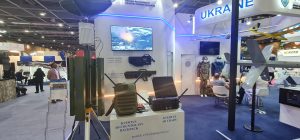By Philip Butterworth-Hayes
On my way to the Eurosatory defence show in Paris last week I met a Ukrainian defence procurement official.
“We have one major priority,” he told me. “We need a network of affordable counter UAS systems which can be fielded on a large scale to identify and take down kamikaze drone threats as soon as they are launched against us. It’s no use waiting until the last kilometre or so. For one thing, our current jammers have a range of one kilometre but Russian attack drones go into autonomous mode 5km away, so the jammers are not effective. Russia is now using more effective stand-off weapon systems which are proving very difficult to track, so we need networks of passive sensors which can alert us to possible attacks as soon as they emerge.”
Would he have found such as system at the Eurosatory show?
While there were some examples of long range, ground-based air defence system concepts on display their missiles were too big and too expensive to meet the challenge of low-cost AI-enabled drone swarms. Instead, what he would have found is a host of new products that western suppliers have developed to protect expensive armoured vehicles from occasional drone attacks, with new mobile weapon stations integrating passive sensors – or active sensors which can operate in short bursts – integrated with airburst ammunition loaded cannons.
These at least are starting to close the affordability gap, in which a USD1,000 drone can take out a USD3 million armoured vehicle. And they could, in theory, form the basis of a network of more mobile air defence systems deployed not just on the battlefield but as measures of last resort to defend critical assets, such as electricity generating stations, many kilometres away from the front.
It is the theoretical effectiveness of these combined systems that prompted one visiting general to the show to assert that the days of drone supremacy in current wars are limited. French Army Chief of Staff General Pierre Schill told visiting reporters :“The life of impunity of small, very simple drones over the battlefield is a snapshot in time,” he said. “Right now it’s being exploited, that’s clear, and we have to protect ourselves. Today, the sword, in the sense of the aerial drone, is powerful, more powerful than the shield. The shield is going to grow.”
But as the C-UAS challenge in Ukraine changes every four weeks, according to some estimates, this is a bold prediction. And drones have changed warfare in ways which many defence departments have not yet fully understood: long-range, low-cost drones are not just tactical weapons they are simultaneously strategic threats used against civilian infrastructure with growing effectiveness.
Over the past two years, European and US defence companies have been busy developing new technologies to make passive and active sensors more mobile around the battlefield, none more so than Germany’s Alpine Eagle, which was at the show to demonstrate its air defence drone – equipped with small but powerful radars for 360% surveillance above the battlefield, which would go some of the way to meeting the needs of Ukrainian procurement officials.
Alpine Eagle is just one application which exploits a new generation of lightweight, robust radar systems. Echodyne was at the show to demonstrate how its portfolio of short, medium range and airborne advanced metamaterial electronically scanned array (MESA) radars that can be integrated into a wide range of ground-based and airborne air defence networks. The company’s products fall outside US International Traffic in Arms Regulations (ITAR) provisions,
Thales had on display its 6×6 Griffon Vehicule d’Observation d’Artillerie (VOA), brimming with sensors to designate ground and air targets, featuring a lightweight Thales MURIN surveillance radar capable of identifying targets 24km in the distance.
Another battlefield drone-scanner was demonstrated by Patria with its Multi-Static Coherent Location (MUSCL) mast-mounted system which can detect NATO class 1 mini and small drones at between 20 and 40km. Hensoldt, meanwhile, featured its TRML-4D C-band ground defence radar using AESA technology can detect up to 1,500 airborne threats out to a range of 250km
Northrop Grumman had its Forward Area Air Defense Command and Control (FAAD C2) system on display, which uses multiple sensors to provide a single integrated air picture (SIAP) to all SHORAD weapons, along with engagement orders and weapon control status to provide complete situational awareness. The system has been supplied to the US Army, the US Air Force, the US Marine Corps and defence organisation in Estonia, Latvia and Lithuania as part of an interoperable Baltic, NATO and US air defence network.
Australia’s DroneShield reported it was doubling the production run of its DroneSentry-X Mk2 CUAS systems by the end of 2024 to meet increasing demand.
As well as getting more mobile, the latest generation of C-UAS systems are becoming more personal. Cerbair launched a new member of the Chimera C-UAS family at Eurosatory, the Chimera 200, weighing around 16 kg with both detection and jamming capabilities. But the prize for the most innovative personal C-UAS system being promoted at the show surely went to VBE Jammer Technology of Shenzhen, which featured an integrated handheld flashlight/drone jammer, able to disrupt GPS, BDS and GLONASS signals.

Ukraine’s Kvertus came to the show with a number of battle-tested C-UAS systems, including this portable C-UAS jamming system which can block signals in the 850-940 MHz frequency ranges used by FPV drones.
There was a handful of new laser C-UAS systems on show.
France’s Cilas exhibited its HELMA-P C-UAS laser weapon, which is being considered for use at the Paris 2024 Olympic Games – to detect, track and neutralise drones up to 1km away. The HELMA-P has also been integrated within MBDA’s Sky Warden C-UAS system, “a modular system designed to integrate and control a large range of sensors and effectors,” said the company. “This scalable system can effectively neutralise any form of threat, from tactical drones to reconnaissance mini-drones, as well as other traditional ‘air breathing’ threats.” India’s Bharat Electronics was also promoting its laser C-UAS D4 system, a Directed Energy Weapon System (DEWS) developed to be integrated with layered network of C-UAS sensors and mitigation methods. No performance data was available. EOS was promoting its directed energy capabilities as part of its Titanis Counter Drone Defence System, which “had disabled Group 1 drones at an effective rate of 20 drones per minute – at ranges of more than 1,000 metres,” according to the company.
Safran had on display its PASEO Master early threat detection system, which was instrumental in the early detection of Houthi launched drones in the Red Sea.
New systems to protect armoured vehicles from drone attacksNo self-respecting NATO armoured vehicle will soon be without a drone defence system, though it will probably take most NATO countries two to three years to equip their ground fleets with new air defence systems, by which time the threat will have evolved. The German Bundeswehr displayed its Puma S1 infantry fighting vehicle (IFV) equipped with a Dedrone Sensor RF-300, designed to passively detect, classify, and locate commercial drones and their remote-control signals. The Scorpion collaborative combat programme from KNDS will equip the French Army armoured vehicles with anti-drone systems within two years, linking their detection capability with turrets that can fire missiles or 40mm airburst grenades. KNDS also launched its Leopard 2 A-RC 3.0 weapons station concept at the show, featuring a remote-controlled 30 mm weapon system for deployment against near-field and aerial threats. Meanwhile, MSI-DS exhibited its mobile and deployable short-range air defence system, the TERRAHAWK PALADIN, to defend and protect against threats from drone and fast incoming air targets, as well as hostile ground and maritime targets, and is capable of integrating a wide range of direct fire effectors up to 40mm, integration of C-UAS missile and rocket systems, ammunition, radar, and tracking options. The latest version of the BAE Systems Hagglunds CV90 infantry fighting vehicle (IFV) was on display, fitted with a C-UAS IRON FIST Active Protection System (APS), which combines a search-and-track radar and infra-red cameras with data fusion algorithms. |
There has clearly been a huge step forward in the last year or so to take on board the lessons of Ukraine, especially in developing better C-UAS protection for armoured vehicles. And for most armed forces, that is the key challenge. But defending targets simultaneously both on and off the battlefield – which is Ukraine’s current massive challenge – will need more consideration to ensure these short-range improvements in defeating the drone threat can somehow be knitted together to provide a more holistic defence system.




